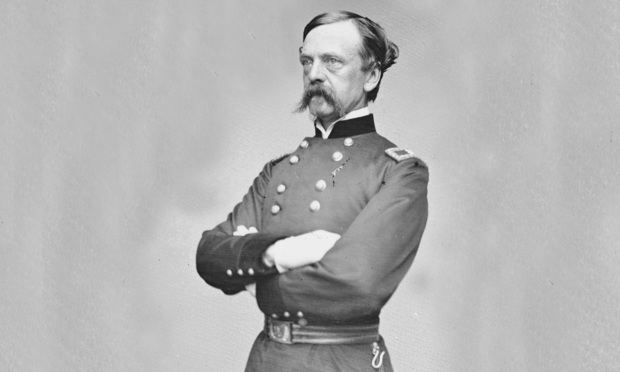The Spooky Tale of the U.S. Attorney Who Was Killed by a Congressman from NY—and Gave Us the Insanity Defense
According to local D.C. lore, a ghost of U.S. Attorney Philip Barton Key II—looking at times like a dark shape or a real person—has been spotted in Lafayette Square, haunting the vicinity of the Federal Circuit courthouse.
October 31, 2018 at 09:53 AM
6 minute read
 Gen. Daniel Sickles.
Gen. Daniel Sickles.
Imagine this: What if the U.S. attorney for the District of Columbia (currently Jessie Liu) was having an affair with the wife of a member of Congress from New York—Democrat Thomas Suozzi represents the district today.
And also, what if Jessie Liu's uncle was Chief Justice John Roberts?
And then, what if Thomas Suozzi learned of the affair and in a jealous rage shot and killed Jessie Liu in broad daylight in Lafayette Square, right in front of the White House?
Think of the headlines. The cable news. The tweets.
As a legal journalist, I'm so sad that I'm 159 years too late for this story.
It really happened. In 1859, Congressman Daniel Sickles of New York murdered U.S. Attorney Philip Barton Key II. Key's father was Francis Scott Key (as in “The Star Spangled Banner”) and his uncle was the fifth U.S. Supreme Court chief justice, Roger Taney.
According to local D.C. lore, Key's ghost—looking at times like a dark shape or a real person—has been spotted in Lafayette Square, haunting the vicinity of the Federal Circuit courthouse. (As if appellate patent arguments aren't scary enough on their own.)
It gets crazier—pun intended. At trial, Sickles pleaded not guilty by reason of temporary insanity and was acquitted. It was the first time the defense was used successfully in the United States.
The lawyers who got him off? Edwin Stanton, who went on to be Secretary of War during most of the Civil War, and was then appointed to the U.S. Supreme Court, only to die a few days later. Also on the team: James T. Brady, who tried 52 criminal cases and only lost one, and attorneys John Graham, Daniel Ratcliffe, Allan Magruder, Samuel Chilton and Phillip Phillips.
Forget O.J. This was the original “trial of the century.”
A little background.
Key, then 42, was a widower and had been described as “the handsomest man in Washington” by a society hostess.
He began having an affair with Teresa Sickles, the socially prominent young wife of the second-term congressman from New York, who was a close confidant of then-President James Buchanan.
Apparently Key would rent a room at the Cosmos Club across Lafayette Square from the Sickles' house and watch through his opera glasses for Teresa to signal from the window for a tryst.
 Sickles (who also had a reputation as a ladies man) was tipped off by an anonymous letter. He confronted his wife, who tearfully confessed to “an intimacy of an improper kind” before swooning, per reports at the time.
Sickles (who also had a reputation as a ladies man) was tipped off by an anonymous letter. He confronted his wife, who tearfully confessed to “an intimacy of an improper kind” before swooning, per reports at the time.
The bout of “temporary insanity” didn't strike until a three days later, when Sickles saw Key skulking around in front of his house, waving a white handkerchief as a signal to Teresa.
Sickles flew into a rage, grabbed three pistols and shot him multiple times, shouting “Key, you scoundrel, you have dishonored my home—you must die!”
Then he picked up Key's opera glasses and turned himself in to U.S. Attorney General Jeremiah Sullivan Black. “He stoutly declined bail, declaring that his only wish was a swift trial. If the Congressman suspected his incarceration would not hurt his cause, he was right,” wrote historian Thomas Fleming.
Sickles was held in the warden's quarters (the jail had bedbugs), and was visited by members of the House and Senate. He even had the company of his dog, Dandy.
The public was sympathetic. “No one believed a jury would, or should, find Sickles guilty of first-degree murder,” wrote journalist/historian Alexis Coe.
On Monday, April 4, 1859, the trial began. According to Edward W. Knappman's Great American Trials, “Of the first 75 potential jurors called, 72 openly sympathized with Sickles. Some 200 were excused for pro-Sickles bias before a jury of tradesmen and farmers could be impaneled.”
Sickles attorney John Graham's opening statement lasted two days. “He meticulously laid out the evils of adultery, quoting Shakespeare's Othello on the agony of discovering the (supposed) infidelity of one's wife,'” Coe wrote. “Graham made a clear distinction between murder, which is committed with malice aforethought, and manslaughter, which is committed in 'a state of heat…the heat of passion that ought to be, but is not, controlled.'”
The prosecutor, hopelessly outmatched, was Robert Ould. “Key's meek and untalented former assistant had little heart for his arduous and unpopular task. Ould inspired so little confidence in Key's relatives that they insisted he take on James Carlisle as assistant counsel, paying his fee out of their own pockets,” Knappman wrote.
The defense made the case all about Key—the cad who seduced his friend's wife—but the prosecutors failed to turn the tables on Sickles and his philandering.
Instead, they argued in vain that the crime was calculated, that Sickles “had come to that carnival of blood fully prepared,” Ould said.
Defense witnesses included the former Secretary of the Treasury, Robert Walker, who according to Coe “described his old friend on the day of the murder as emitting 'an agony of unnatural and unearthly sounds,' fearing 'if it lasted much longer he must become insane.' Halfway through Walker's testimony, Sickles burst into tears and it took three men, including his father, to help him leave the courtroom.”
According to court records, Brady instructed the jury that if they believed Sickles “became, or was mentally incapable of governing himself in reference to Mr. Key as the debauchee of his wife,” then that means “he is not guilty of any offence whatever.”
It took the jury just 30 minutes of deliberations to agree.
After Sickles was acquitted, the courtroom broke into applause. But his public support evaporated when he announced that he forgave his wife. He became an outcast.
No happy endings for anyone, I'm afraid.
As for the legacy of the case, insanity endured as a sometimes dubious defense until 1984, when Congress passed the Insanity Defense Reform Act, making it far more difficult to successfully invoke.
We hope you enjoyed this excerpt from Litigation Daily, the exclusive source for sharp commentary on mega court battles, winning strategies and the issues that obsess elite litigators. Click here to subscribe.
This content has been archived. It is available through our partners, LexisNexis® and Bloomberg Law.
To view this content, please continue to their sites.
Not a Lexis Subscriber?
Subscribe Now
Not a Bloomberg Law Subscriber?
Subscribe Now
NOT FOR REPRINT
© 2025 ALM Global, LLC, All Rights Reserved. Request academic re-use from www.copyright.com. All other uses, submit a request to [email protected]. For more information visit Asset & Logo Licensing.
You Might Like
View All


Trending Stories
- 1South Florida Attorney Charged With Aggravated Battery After Incident in Prime Rib Line
- 2'A Death Sentence for TikTok'?: Litigators and Experts Weigh Impact of Potential Ban on Creators and Data Privacy
- 3Bribery Case Against Former Lt. Gov. Brian Benjamin Is Dropped
- 4‘Extremely Disturbing’: AI Firms Face Class Action by ‘Taskers’ Exposed to Traumatic Content
- 5State Appeals Court Revives BraunHagey Lawsuit Alleging $4.2M Unlawful Wire to China
Who Got The Work
J. Brugh Lower of Gibbons has entered an appearance for industrial equipment supplier Devco Corporation in a pending trademark infringement lawsuit. The suit, accusing the defendant of selling knock-off Graco products, was filed Dec. 18 in New Jersey District Court by Rivkin Radler on behalf of Graco Inc. and Graco Minnesota. The case, assigned to U.S. District Judge Zahid N. Quraishi, is 3:24-cv-11294, Graco Inc. et al v. Devco Corporation.
Who Got The Work
Rebecca Maller-Stein and Kent A. Yalowitz of Arnold & Porter Kaye Scholer have entered their appearances for Hanaco Venture Capital and its executives, Lior Prosor and David Frankel, in a pending securities lawsuit. The action, filed on Dec. 24 in New York Southern District Court by Zell, Aron & Co. on behalf of Goldeneye Advisors, accuses the defendants of negligently and fraudulently managing the plaintiff's $1 million investment. The case, assigned to U.S. District Judge Vernon S. Broderick, is 1:24-cv-09918, Goldeneye Advisors, LLC v. Hanaco Venture Capital, Ltd. et al.
Who Got The Work
Attorneys from A&O Shearman has stepped in as defense counsel for Toronto-Dominion Bank and other defendants in a pending securities class action. The suit, filed Dec. 11 in New York Southern District Court by Bleichmar Fonti & Auld, accuses the defendants of concealing the bank's 'pervasive' deficiencies in regards to its compliance with the Bank Secrecy Act and the quality of its anti-money laundering controls. The case, assigned to U.S. District Judge Arun Subramanian, is 1:24-cv-09445, Gonzalez v. The Toronto-Dominion Bank et al.
Who Got The Work
Crown Castle International, a Pennsylvania company providing shared communications infrastructure, has turned to Luke D. Wolf of Gordon Rees Scully Mansukhani to fend off a pending breach-of-contract lawsuit. The court action, filed Nov. 25 in Michigan Eastern District Court by Hooper Hathaway PC on behalf of The Town Residences LLC, accuses Crown Castle of failing to transfer approximately $30,000 in utility payments from T-Mobile in breach of a roof-top lease and assignment agreement. The case, assigned to U.S. District Judge Susan K. Declercq, is 2:24-cv-13131, The Town Residences LLC v. T-Mobile US, Inc. et al.
Who Got The Work
Wilfred P. Coronato and Daniel M. Schwartz of McCarter & English have stepped in as defense counsel to Electrolux Home Products Inc. in a pending product liability lawsuit. The court action, filed Nov. 26 in New York Eastern District Court by Poulos Lopiccolo PC and Nagel Rice LLP on behalf of David Stern, alleges that the defendant's refrigerators’ drawers and shelving repeatedly break and fall apart within months after purchase. The case, assigned to U.S. District Judge Joan M. Azrack, is 2:24-cv-08204, Stern v. Electrolux Home Products, Inc.
Featured Firms
Law Offices of Gary Martin Hays & Associates, P.C.
(470) 294-1674
Law Offices of Mark E. Salomone
(857) 444-6468
Smith & Hassler
(713) 739-1250







